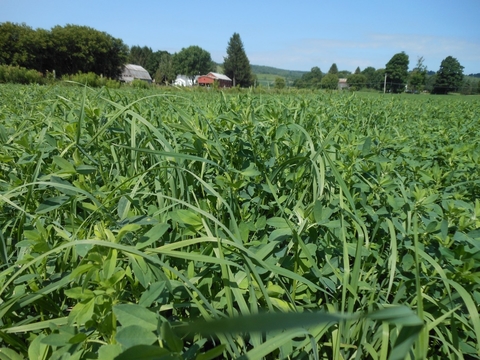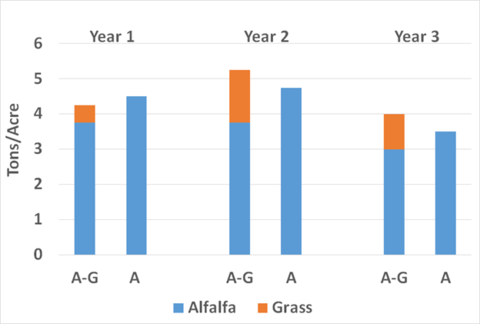Quick facts
- Simple and complex legume-grass mixtures have the potential to provide both agronomic and livestock feeding benefits.
- Legume and grass species for the mixture should be selected based on harvest regimes and environmental conditions.
- Mixtures containing 30 to 40% grasses are typically recommended, but depend on seeding date, stand age, and harvest schedule.
- Orchardgrass, tall fescue, and meadow fescue are most compatible with alfalfa harvest systems and rotational grazing.
The most compelling reasons to use mixtures containing both legumes and grasses are related to the benefits of plant diversity on sward productivity, yield persistence, and livestock nutrition.
Advantages of a forage mixture
Legumes and grasses have unique leaf and root traits that allow for greater combined use of light, moisture and minerals. Select legume and grass mixtures that work well with your harvest schedule and environmental conditions.
Forage mixture benefits:
- Legumes have unique root systems. Nodules on legume roots can fix nitrogen from the air for their own nutrition and can transfer up to 50 lb/acre to grasses growing in with them. Because of their tap roots, some legumes like alfalfa are able to absorb water from deeper in the soil than grasses and have greater drought tolerance than grasses.
- Winter hardy grasses have broad crowns. Grasses grown in a mixture with tap-rooted legumes like alfalfa provide protection for legumes from winter injury associated with the heaving of soils. Grasses also are more traffic tolerant than legumes and can protect legume crowns from wheel traffic.
- Winter hardy grasses have greater tolerance of environmental stress than legumes and even some grasses like ryegrass. Growing winter hardy grasses with legumes can provide greater overall stand persistence and yield if one or more of the mixture components should die.
- Faster field drying times. Grasses typically contain less moisture than forages which reduces field drying times.
Grasses can contribute to livestock rations:
- Grasses contain more highly digestible fiber than legumes.
- Grasses have lower levels of non-fiber carbohydrates (NFC) (15%) than alfalfa (25%) and corn silage (35%).
- Grasses reduce the risk of frothy legume bloat in cattle and sheep grazing clovers and alfalfa (when ≥40% of the stand).
- Immature grasses can increase the overall palatability of mixtures.
How much grass should be in the sward?
To provide both agronomic and ruminant nutrition advantages, a minimum of 30-40% grass should be in a mixture with legumes in a sward. The ideal level of grass may vary depending on the use of forage in grazing and livestock feeding.
When feeding dairy cows at the peak of production with high protein and energy needs, a grass composition as low as 20% may be desirable. As much as 40-60% grass is likely desirable for grazing beef cows and calves. It is important to test forages for nutrient composition when using legume and grass mixtures in cattle rations.
While we can establish target composition goals it is important to recognize that the legume-to-grass proportion is affected by the time of seeding and will vary both within a season and over the life of the stand.
- Grasses will establish better with early spring and later summer seeding and without competition from weedy grasses and grass companion crops. In much of Minnesota, the best time for grass establishment is in late summer but before September.
- Grass proportion in mixtures will typically be highest in the spring and fall when temperature and moisture availability are best. Cool-season grasses undergo a summer slump and have lower yields from late June through September.
- Grass proportion in mixtures often increases with increased stand life because legumes are less persistent than grasses.
Determining sward composition
Sward composition can be determined visually and by hand separating subsamples. Visual determination of legume-grass mixture swards can be challenging but is quite accurate with experience.
Typically we only look at the top of the canopy, but adjustments need to be made to compensate for what is hidden within the canopy. Hand separation of subsamples taken following visual observation can be very accurate as long as at least 10 square feet and representative samples are taken across a field. The sample can be separated into grass-legume components by hand and then weighed.
Simple mixtures
Simple mixtures should contain at least one legume and one grass that are compatible in terms of tolerance to harvest management and environmental conditions. The proportion of each in the mixture will depend on what livestock is fed and whether it is used for grazing or haying.
To provide 30-40% grass in mixtures, seeding rates of 4, 6, and 6 lb/acre are recommended for orchardgrass, tall fescue, and meadow fescue, respectively, in the forage-grass mixture. These grasses have similar yield potential, but meadow fescue has somewhat higher forage fiber digestibility. For cool-season grasses, stem elongation and flowering occur in the spring, and only leaves remain at later harvests during the year.
Orchardgrass and tall fescue can compete with and crowd out alfalfa as stands age. Varieties of all grasses should be selected that mature later than alfalfa flowers to reduce the fibrous stems in the forage to maintain quality.
In a rotational grazing study from Wisconsin, differences in average daily gain were associated with a greater proportion of alfalfa in the alfalfa-grass mixtures. The authors also concluded that meadow fescue was more compatible with alfalfa and provided a better grass-legume balance.
Steer gain while rotationally grazing alfalfa-grass mixtures in Wisconsin*
| Mixture | Proportion grass % |
Biomass yield tons/acre |
Avg. daily gain lb/day |
Gain per acre lb/acre |
|---|---|---|---|---|
| Alfalfa-meadow fescue | 61 | 4.7 | 1.8 | 885 |
| Alfalfa-orchardgrass | 78 | 4.3 | 1.2 | 670 |
| Alfalfa-tall fescue | 77 | 4.9 | 1.3 | 681 |
*Results from a 3-year-old stand. Differences in average daily gain were associated with a greater proportion of alfalfa in the mixture. Source Nieman et al., 2019 Agron J. 11:686.
Timothy and smooth bromegrass are no longer recommended for mixtures with alfalfa because these grasses will not persist in an aggressive, three- or four-cut harvest regime typically used in alfalfa-growing regions of Minnesota. Timothy and smooth bromegrass perform best in a two-cut harvest regime. Timothy is adapted to mixtures with birdsfoot trefoil grown on low pH or wet soils.
Complex mixtures
Complex mixtures contain two or more legumes and grasses that provide unique contributions to the mixture, such as adaptability to the environment, management advantages, or enhanced livestock nutrition. An example of a complex mixture intended for beef cattle grazing is shown in the table below.
This complex mixture will produce a sward that is predominately grasses based on seeds (60:40) with about equal proportions of orchardgrass, tall fescue, and meadow fescue. Variety names are not provided but all grasses have been selected for high quality. All of the grasses persist well if rotationally grazed from 4-5 times per year.
- Orchardgrass matures late.
- Tall fescue has soft leaves for greater palatability and is endophyte-free (endophytes produce alkaloids in tall fescue that reduce palatability).
- Meadow fescue is high in fiber digestibility.
Perennial ryegrass is included for its high seedling vigor, quick ground cover and high forage quality, but it lacks winter hardiness and will not provide long-term persistence.
Alfalfa varieties are grazing tolerant and should be compatible with grasses. The creeping rooted type of alfalfa has potential to spread and reduce late winter heaving but has less yield potential than standard alfalfa varieties.
A small amount of red clover and birdsfoot trefoil are included to increase legume diversity. Red clover has greater seedling vigor than alfalfa and will likely provide some yield enhancement during the first year of production. Birdsfoot trefoil, a tannin-containing legume, has the potential to reduce bloat and increase protein by-pass, but its low seedling vigor might limit its establishment except in areas where there is little competition.
An example of a complex forage-grass mixture developed for beef grazing in western Minnesota*
| Grass or legume component |
Proportion of mix % |
Seeds per pound | Seeds per sq. ft @ 20 lb/acre |
|---|---|---|---|
| Tall fescue | 22 | 190,000 | 18 |
| Meadow fescue | 22 | 220,000 | 22 |
| Orchardgrass | 11 | 590,000 | 30 |
| Perennial ryegrass | 11 | 280,000 | 10 |
| Grazing alfalfa | 11 | 220,000 | 22 |
| Creeping alfalfa | 11 | 220,000 | 22 |
| Medium red clover | 6 | 275,000 | 6 |
| Birdsfoot trefoil | 6 | 375,000 | 8 |
| Total seeds per ft2 | 138 |
*The mixture is intended for seeding in mid-August at a rate of 20 pounds per acre.
Note: This mixture contains about 60% grass seeds and 40% legume seeds. Seventy-five seeds per sq. ft. are normally adequate for stand establishment under good conditions, assuming good soil-seed contact and seeding at 1/4 inch depth. About 10 pounds of this mixture per acre should be adequate under ideal conditions. However, it was seeded at 20 lb. per acre to ensure successful establishment.
Reviewed in 2023



